CAMILA SIMONIN
 |  |  |  |
|---|
We're Going Back To Something We've Never Seen Before (November 2024)
"We're Going Back to Something We've Never Seen Before" is a performance made in the aftermath of the results of the last election that named Donald Trump as the 47th president of the United States.
Interested in this idea of bringing a moment in history to be our present and future, in this piece I play with the work of two artists from the 1960s. The first is a piece by the American artist Bruce Nauman, in which he worked with movement and choreography to create "Walking in an Exaggerated Manner Around the Perimeter of a Square" (1968). The second is Parangolés, capes made by the Brazilian artist Hélio Oiticica from 1964 to 1979, worn during the Brazilian dictatorship with sayings such as "I embody the revolution" and "From adversity we live". Both artists were using different media and materials to question what constituted art making and its connection to both everyday life and politics.
Across the country, the Harris-Walz campaign made people repeat the sentence "we're not going back": not going back to having Donald Trump in the White House and not going back to a past of violence, injustice and discrimination against a (now) large part of the population of the United States. And yet, here we are. Trump's speeches are often filled with sentences like "we've never seen anything like it", "we've seen this before in this country" etc. The title of the performance, then, is a merging of the two slogans to talk about this non-linearity that works as a threat for the contemporary far right across the globe and its desire to go back and yet be a political transnational movement that we've never seen before.
 |  |  |  |
|---|
Coming to Term (March 2024)
In Coming to Term, I am interested in the questions: “Have you ever been told the circumstances of your nation’s birth?” and “Can a nation be born multiple times?”.
The piece is also a way to represent the contemporary far right as a transnational wave, to investigate the gestures of right-wing leaders and to perform with/against their words. In addition, I see it as a way to (1) highlight the phenomenon of the far right across the globe as a choreographic aesthetic movement and (2) understand how the contemporary far right captured tactics of mobilization from the left for their own populist project to become a possible political scenario in many countries.
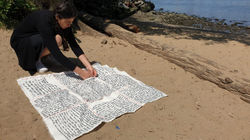 | 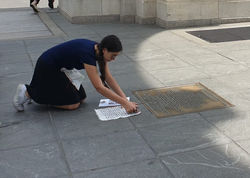 | 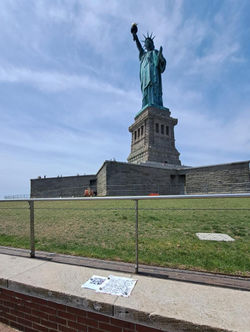 | 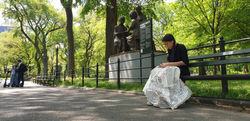 |  |
|---|
Work in Progress (Spring 2023)
On 12-inch squares, embroider descriptions of modifications made to the Brazilian flag. Attach the squares with red thread to a Brazilian flag, also embroidered, without the traditional colors, but with a white background and black lines that read "work in progress". Carry such a flag around New York City, and at each stop unstitch one square and leave it there next to a QR code that provides a link to the piece of art being described. Do this until all the squares have been removed and only the Brazilian-draft-flag can be seen.
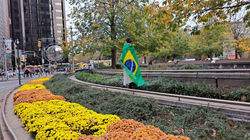 | 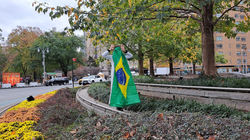 | 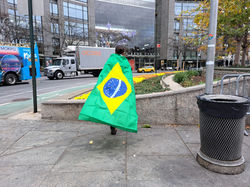 |
|---|
Republican Progress in Circle (November 2022)
On November 15, 2022, the day of the proclamation of the Republic of Brazil, go to Columbus Circle in New York City to take a walk along the footpath on the perimeter of the plaza. Reverse the direction of the walk. When walking forward, walk slowly, and when walking backwards, do it with sudden, quick steps. Wear white clothing and Brazil's national flag. When walking forward, the flag hangs down the back like a superhero cape and when walking backwards, the fabric is reversed like a veil. Start clockwise and forward. Estimated duration: one lap around Columbus Circle.
 |  | 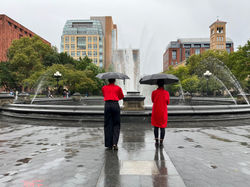 |
|---|
Revolution, just couch Che Guevaras (October 2022)
Performative program: On October 2, 2022, go to Washington Square Park wearing a red shirt and black pants. Race the other participant, Leonor Mendes, to see who gets last to the finishing line. The competition is also a counter-march, marching/running backwards, so that the backs of the competitors always face their final destiny. Hold a black umbrella throughout the entire process. Starting line: Fountain. Finishing line: red couch positioned under the arch. Estimated duration: counting of the votes for the first round of Brazil’s presidential election. On October 2, that duration was from 4pm to 8pm. Repeated the same program on October 30 for the run-off.
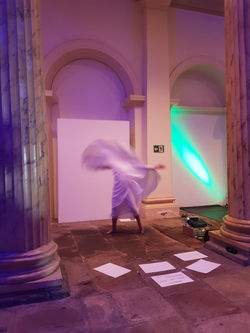 | 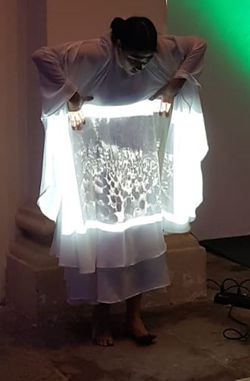 | 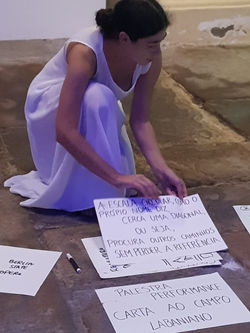 |
|---|
A letter to the LMA field (June 2022)
In its character of lecture-performance, this piece was thought to be originally presented at the LABAN 22+100: Intenational Conference. The work uses studies of the Spatial Scales of the icosahedro, of the Body-Space Connections and gestures that, when overlapped with the reading of a letter addressed to the movement analysis field in which several aspects of its History are critized, it create layers of meaning about the knowledge we continuously produce within the field.
 |  |  |
|---|
BR-18 (October 2018)
"BR-18" was presented in Rio de Janeiro in the middle of the last presedential elections. Our last day of performance happened simultenously with the counting of votes that would declare Bolsonaro's victory over the left-wing party. BR-18 is an attempt to frame the Brazilian circumstances for the working class during the year of 2018 regarding the elections and unemployment.
 |  |  |
|---|
Revolução na América do Sul (July 2018)
"Revolução na América do Sul" is a play written by Augusto Boal. Staged in 2018, the performance targeted the story of "José", a construction worker who has to live absurd situations to survive in an election year.
Award winner for distinguished director and play (FETAERJ).
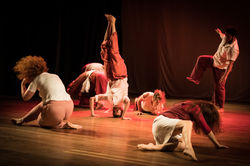 |  |  |
|---|
Fronteiras Invisíveis (December 2019)
"Fronteiras Invisíveis" was the collective performance organized from a Residence in "Centro Coreográfico - Rio de Janeiro" with the Belgium choreographer Marie Close. The piece addressed the term "Balbúrdia", used by the Brazilian federal governement to deligitimize and characterize as chaotic and "messy" the art work produced in Federal Universities.
 |  |  |  |
|---|
Romola&Nijinsky (August 2019)
Romola&Nijinsky was a site-specific piece connecting both theatre and dance language that took place at the three floors of a historical patrimony palace in Rio. The performance was based on Nijinsky's diaries and showed the couple's life, discussing themes such as fluid sexuality and mental health.
Nominated for Best Movement Direction (APTR)
 |  |  |  |
|---|
CRUA (October 2019)
"CRUA" puts forward many narratives from people living on the streets of Rio de Janeiro. During the creative process, all the artists involved organized meetings, picnics and other gatherings at public squares in Rio to get to know some of those stories in what we called "Ensaios-Partilha". The group also contacted a number of social movements and organisations that dealt with homeless and street living issues and causes.
 |  |
|---|
Rinocerontes (June 2016)
"Rinocerontes" is a play written by Eugène Ionesco. Staged in 2016, after former-president Dilma's impeachment act, the performance involving public high school students tackled the transformation proposed by Ionesco as an openess attitude towards fascism in Brazil.